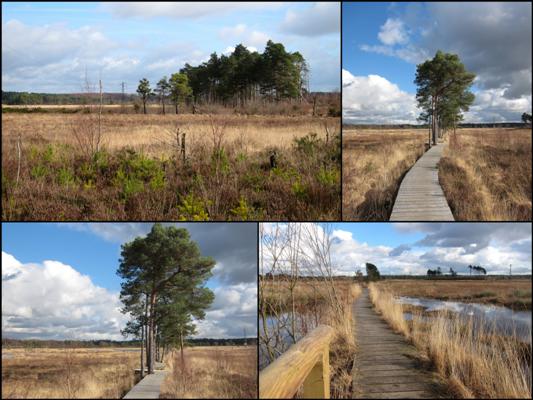Yesterday I made a return visit to one of my favorite heathland locations, Thursley Common. It is one of the largest remaining fragments of Surrey heath and includes areas of lowland heath, mire and woodland. The site supports a range of typical heathland wildlife including large invertebrate populations. The reserve's mixture of mire and wet heath is one of the finest examples of its type in southern England. The views above were taken in mid February and show the open and somewhat bleak nature of this very important habitat.
Last year the boardwalk which winds out across one of the many wetter areas towards Pine Island was replaced and provides an excellent place to scan around for some of the resident and migrant wildlife.
While focusing on a male Stonechat (back-lit by the strong sunshine) perched atop a young pine tree I heard the very distinctive calls of a Curlew and just managed a couple of hurried shots as one individual flew low across the heath and disappeared amongst the heathers and grasses. I eventually logged 4 individuals feeding and calling to one another. Scanning overhead produced views of at least 5 Hobby hawking insects very high over the common for about 15 minutes before they also disappeared northwards.
Curlews were very regular winter visitors in the 19th century with breeding first recorded at Chobham Common in 1893 and the number of breeding pairs peaked at 12 - 14 pairs at various Surrey sites in the 1940's. As far as I am aware, Thursley/Ockley Commons is now the only location within Surrey where at least one pair has attempted to breed since 1970. They usually arrive in mid February and depart during July.
This wide open landscape is dominated by plants such as Heathers, Gorse and heathland grasses and punctuated by scattered trees such as Silver Birch and Pines. In July 2006 around 60% of the habitat was destroyed by fire but slowly nature is returning although sightings of Dartford Warbler which were previously relatively easy to locate are now very scare and I didn't hear or see one during this walk. Apart from some habitat loss, the recent cold, wet winters have obviously had a dramatic effect on this species but hopefully their numbers will increase so we can all enjoy this charismatic little bird.
On sunny days the wide open sandy tracks are a good spot to locate butterflies soaking up the warmth. While I saw Brimstone, Peacock and Green Hairstreak (images saved for another post) the only species that stopped for a photo-call was this Speckled Wood.
Bird sightings during my walk were not particularly numerous but included several Common Buzzard, including one perched on the remains of a Birch tree, Kestrel, Sparrowhawk, Woodlark, Meadow Pipit, Tree Pipit, Green and Great Spotted Woodpecker, a couple of male Redstarts, Chaffinch, Goldfinch, Willow Warbler, Common Whitethroat, Crow, Jay, Grey Heron, Greylag Geese, Mallard, Tufted Duck and a male Cuckoo.
Another Stonechat.









you had a beautiful day with blue skies and puffy clouds. like the boardwalk!
ReplyDeleteTheresa. It was great to be out and about in the sunshine at long last.
DeleteLovely place to go and listen for nature. The Stonechat is my favourite, fantastic.
ReplyDeleteCheers Bob. The Stonechat alway makes it's presence known with its distinctive call.
DeleteWow! what a fabulous place to walk Frank.
ReplyDeleteRoy. It's good at any time of year but can appear somewhat bleak on grey days!
DeleteSo Roy, will you be talking a walk here soon as well?
DeleteNice photos, Frank! It looks like a place I'd enjoy seeing.
ReplyDeleteThanks Mona. I'm sure you would enjoy a stroll around the common.
DeleteHi Frank....I so enjoy seeing what other parts of this old world looks like!!
ReplyDeleteAll the different birds,flower, butterflies, and landscapes!!
Thanks for sharing your "neck of your woods on the other side of the
pond"...love that yellow flower : )
Grace
Thanks for coming by and your comment!!
Hi Grace. Always delighted to share one of my favourite walks with you.
Deletethe pine trees are interesting. obviously they were planted there. How come they grow and other trees don't? It's an interesting way to make a boardwalk.
ReplyDeleteRed. The Pines are typical inhabitants of sandy heathland. There are other tree species, particularly Birch, but unlike the Pines many have succumbed to the various fires. Historically the area was grazed to keep down young saplings so that the natural grasses and heathers would survive. The boardwalk is far more visitor friendly than it used to be!
DeleteGreat post Frank, and the pictures reminded me of my visit there a few years ago with you.
ReplyDeleteHi Keith. Yes, good memories.
DeleteI have been to Thursley before and found it just as you say Frank. I'd like to find the time to do it again but my time at the moment is gobbled up with other things.
ReplyDeleteCheers Mike. Well, when you do find a spare moment just let me know.
DeleteHi Frank!!!.. Fantastic place.. Beautiful collage. regards
ReplyDeleteHi Ana. Thanks, I always appreciate your visit and comments.
DeleteI love thtat trail and the stonechat. I hope I will see one soon ;-) Beautiful pictures Frank.
ReplyDeleteCheers Chris. I do hope you get to see one soon.
DeleteFrank, this looks like a FABulous place to walk and bird! I love it! all those bird species would be new to me, except the curlews. I wonder why the offspring do not return and set up breeding as well? Too bad about the lose of those warblers. I do hope they return as the habitat restores itself! Wonderful series of photos and great information. Thanks for posting this.
ReplyDeleteKathie. Most Curlews breed further north and I guess this particular lowland habitat will only support limited numbers .. that is ONLY IF they are successful.
ReplyDelete